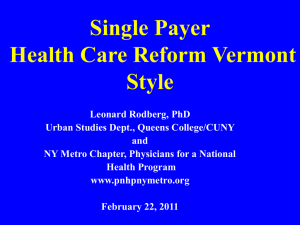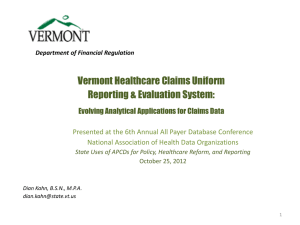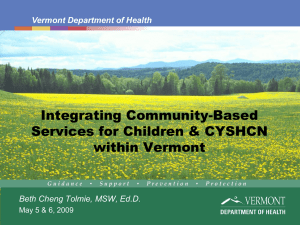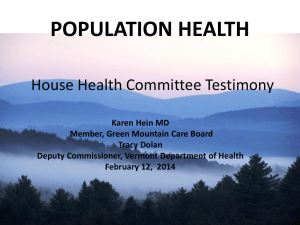Paying for Health Care Reform: Single Payer vs
advertisement
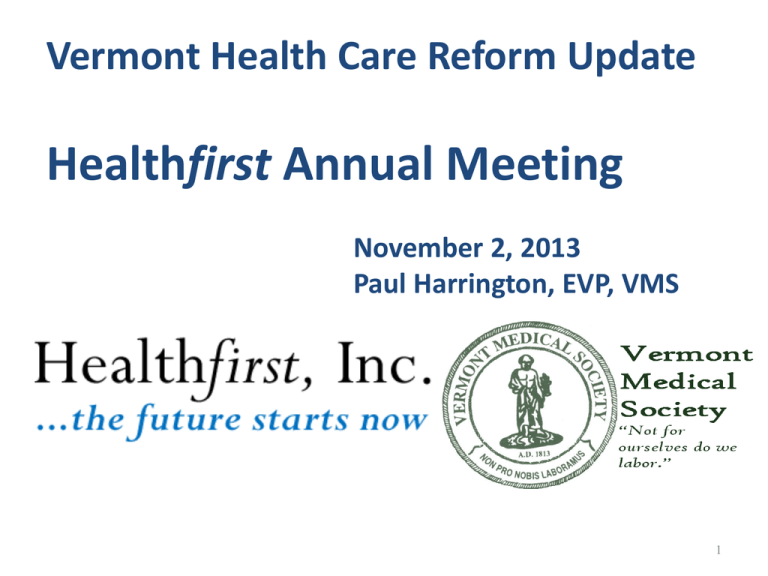
Vermont Health Care Reform Update Healthfirst Annual Meeting November 2, 2013 Paul Harrington, EVP, VMS 1 Patient Protection and Affordable Care Act (ACA) H.R. 3590, 3/23/10 • Individual Mandate – Requires all U.S. adult residents to obtain and maintain “ acceptable coverage” for themselves and their children beginning in 2014 (phased-in tax penalty for those without insurance) • Insurance Market Reforms – Require all health insurers to offer basic plans that are guaranteed issue, with no health status underwriting, with no pre-existing condition exclusions and maximum rating bands of 3:1. • Subsidies to purchase insurance available through exchanges to low-income individuals – Up to 400% of Federal Poverty Level ($44K individual, $60K couple & $92K family of four in 2012) • Health Insurance Exchanges – Exchanges available in 2014 to give individuals the ability to choose from a variety of private plans and receive subsidies. State can set insurance company participation and set conditions for participation. 2 “Meaningful use of Certified EHR Technology” $44K Medicare/$64K Medicaid bonus, Penalties 2015-2019 (1-5%) • EHR meets established standards and includes: – patient demographics and clinical data – medical history and problem lists – clinical decision support – physician order entry – capture/query quality health care data • Use e-prescribing; electronic exchange of patient information; integration with other systems; and, EHR reporting of clinical quality data • Increased coding complexity due to need to be HIPAA 5010 compliant by Jan. 1, 2012 (enforcement June 1, 2012) and the change from ICD-9 to ICD-10 by Medicare on Oct. 1, 2014. ICD-9 has 15,000 codes while ICD-10 has 68,000 codes. • Stage 2 of Meaningful Use starts on January 1, 2014 3 2011 Health Care Reform Bill H.202 - Act 48 • Green Mountain Care Board: 5 person established to oversee cost containment strategies • Vermont Health Connect: Benefit Exchange created in Medicaid Dept. to help achieve universal insurance coverage, as required under the federal Patient Protection and Accountable Care Act (ACA). • Green Mountain Care: Anticipates the evolution of the Health Benefit Exchange into Green Mountain Care: the state’s publicly financed single-payer health care system for all Vermonters beginning in 2017. 4 Vermont’s Fragile Health Care System 14 Hospitals and Approx. 1,833 physicians Due to expanded insurance coverage, State estimates the current shortage of 25 primary care physicians will increase to 63 in 2015. Primary Care = 35% (634) • Family Practice = 15% (279) • General Internal Medicine = 10% (175) • OB/GYN = 4% (75) • Pediatric = 6% (105) Specialty Care = 65% (1,199) • Anesthesiology = 5% (97) • Emergency Medicine = 6% (108) • Spec.Internal Medicine = 12% (217) • Psychiatry = 9% (172) • Radiology = 7% (129) • Surgery = 9% (162) • Other = 17% (314) 5 Act 171: 2012 Health Care Reform Bill Established Vermont Health Connect Exclusive Health Benefit Exchange • Beginning on Jan. 1, 2014, the exchange will help provide qualified health benefit plans to eligible individuals and small businesses with 50 or fewer employees and employers with 100 employees or fewer in 2016. • DHVA/Medicaid Dept will contract with BCBSVT and MVP. • Federal premium subsidies will be available to individuals who enroll in exchange plans (at silver plan level) – provided that their income is above 133 % of FPL and no more than 400 % of FPL. • Estimated enrollment in 2014 = 115,000 (626,000 total) • Medicaid will cover individuals and families up to 133%6 FPL 6 Vermont Health Connect Enrollment Begins on October 1, 2013 • Individuals can enroll in the system from October 1, 2013 through March 31, 2014. • Small businesses will have an open enrollment period beginning on October 1, 2013 and ending on December 15, 2013 • Insurance payments will be to the State of Vermont and the state will forward premium payments to BCBS or MVP. 7 Catamount & VHAP Sunset Under Vermont Health Connect • Both VHAP and Catamount will end on 12/31/13 • Vermonters in these programs will transition based on their income to either Medicaid or a private plan under Vermont Health Connect 2013 2014 Medicaid BCBS or MVP VHAP 38,602 28,587 10,015 Catamount 11,427 2,294 9,133 8 The four levels of insurance coverage - bronze, silver, gold and platinum - are based on actuarial value, a measure of the level of financial protection a health insurance policy offers 9 Federal Subsides Available Only Through Vermont Health Connect • Under the ACA, individuals who purchase insurance after January 1, 2014 through an Exchange will be eligible for subsidies for health insurance premiums and cost-sharing if their income is less than 400 percent of the federal poverty level (FPL). • The subsidy is based on the premium for a benchmark plan (the second lowest cost silver plan available in an Exchange). • A subsidy calculator can be found at: http://healthconnect.vermont.gov/tax_credit_calcul ator 10 Green Mountain Care: Vermont Single-Payer • Occurs after Affordable Care Act waiver (Jan. 1, 2017 under current law) and other requirements are met – Section 1332 provides waiver for state innovation allowing states to opt-out of specific provisions of ACA – Collect all federal funding for exchange ($267 million). – Coordination with Vermont’s Global Commitment Medicaid section 1115 waiver. • All Vermonters covered by virtue of residency • Minimum benefits set by Green Mountain Care Board • Overall health care budget set by GMC board subject to legislative appropriations 11 Financing Green Mountain Care Debate to take place during 2015 legislative session • Section 9 of Act 48 requires that the administration bring to the legislature 2 financing plans One plan shall recommend the amounts and necessary mechanisms to finance any initiatives which in order to provide coverage to all Vermonters in the absence of a waiver from ACA Section 1332 The second plan shall recommend the amounts and necessary mechanisms to finance Green Mountain Care and any systems improvements needed to achieve a public-private universal health care system. • Financing must maximize federal funds and spread costs fairly • Many issues to be resolved, including What will the overall costs/savings be? How much federal funding will Vermont receive? How does the state deal with border issues? How are public and private coverage integrated? How do does Vermont incorporate ERISA plans? 12 UMass and Wakely Consultants, 1/24/13 Vermont Health Care Reform Financing Plan • Total GMC Base Costs = $3.498 billion – GMC Savings in 2017 = $35 million (1.0%) with Provider reimbursement $155 million lower • $1.61 billion of GMC costs needs to be raised by new financing plan. – Top 5 State Revenue Streams = $1.28 Billion (Personal Income = $624.6, Sales &Use =$349.2, Meals &Rooms = $132.2, Corporate Income = $94.1, Purchase and Use = $83.7). • Key Assumptions: – GMC as primary pays health care providers 105 percent of Medicare rates. – Assumes administrative costs of 7 percent that may be difficult to achieve due to Medicare, out-of-state patients and large ERISA employers offering insurance. • Financing Plan to be presented on 1/15/15 to Legislature 13 Partners for Health Care Reform (PHCR) • PHCR is a group made up of health care providers, employers, and a health plan provider interested in providing essential information based on factual data and research-based analyses to shape the smart and effective reform of Vermont’s health care system. • Group Members: – Fletcher Allen Health Care – Vermont Chamber of Commerce – Vermont Assembly of Home Health and Hospice Agencies, Inc. – Blue Cross Blue Shield of Vermont – Vermont Association of Hospitals and Health System – Vermont Medical Society – Vermont Business Roundtable • Contacted with Avalere Health for an independent Evaluation of the 1/24/13 Vermont Health Care Reform Financing Plan. Report will be presented to the Health Care Oversight Committee on November 14 14 State Roles in Payment and Delivery System Reform • Green Mountain Care Board: – Regulator and Policy Maker – Payment and Delivery System Reform including pilots – Payer and provider payment policy • DVHA: Payer – Medicaid payment • SIM Project: – Opportunity to test multi-payer payment reform models and coordinate efforts among many stakeholders. Publicprivate initiative to guide acceleration and expansion of payment and delivery system reforms 15 Vermont’s State Health Care Innovation Plan (SIM grant request for $45 million, 4/13-12/16) VT payers (Medicaid and Commercial) will test three existing Medicare models: the Shared Savings Accountable Care Organization, Bundled Payments and Pay-for-Performance. The three models have four aims: 1. Increase both organizational coordination and financial alignment between advanced medical home primary care practices and specialty care; 2. Implement and evaluate the impact of value-based payment methodologies; 3. Coordinate a financing and delivery model for 22,000 Vermonters duallyeligible for Medicare and Medicaid; and 4. Accelerate development of a Learning Health System infrastructure 16 SIM Project Structure AHS Health Services Enterprise Project Management Office (includes Global Commitment Waiver ) SIM Core Team SIM Government Operations Project Director SIM Steering Committee Health Information Exchange Workgroup Quality & Performance Measures Workgroup Payment Model Standards Workgroup Population Health Workgroup Care Models & Care Mgmt Workgroup Workforce Steering Committee 17 VT Medicare Shared Savings Plan ACO Models For 3 Years with no “downside risk” 50% of saving retained by CMS with 50% to ACO Reporting on 33 quality measures Accountable Care Coalition of the Green Mountains: An IPAcentric ACO consisting of 100 physicians statewide received designation as a CMS SSP-ACO beginning July 1, 2012. OneCare: A Hospital-centric ACO: Fletcher Allen and DartmouthHitchcock, 13 of Vermont's Community Hospitals,3 FQHCs and a number of independent physicians have collaborated to become an ACO under the CMS SSP beginning Jan. 1, 2013. FQHCs: Six of the State’s eight Federally Qualified Health Centers (FQHCs) have formed Community Health Accountable Care (CHAC), Proposed for January 1, 2014 18 VT Commercial and Medicaid Shared Savings Plan ACOs Reporting on an Additional 21 Measures • For 3 Years with no “downside risk” for Medicaid and for 3 Years with “downside risk” in year 3 for Commercial • 75% to 40% of saving retained by Payers with 25% to 60% to ACO • Potential pool is all Vermont Health Connect enrollees and the Medicaid population • Participating payers include BCBSVT, MVP Health Care and Medicaid • Potential ACOs include OneCare, Accountable Care Coalition of the Green Mountains, and Community Health Accountable Care • Goal is to begin the Commercial and Medicaid Shared Savings Plans on January 1, 2014 19 Medicare, Commercial and Medicaid ACO Measures for 2014 • Under the Medicare MSSP ACO, there are a total of 33 quality measures: 26 clinical measures and 7 patient satisfaction measures. Of the 26 clinical measures, 19 will be used to help determine the level of any shared savings. • For the proposed BCBSVT and MVP commercial plan ACOs and the Medicaid ACOs, in addition to the 33 Medicare MSSP measures, the workgroup has added 21 additional measures: 12 clinical measures and 9 patient satisfaction measures. • The addition of 21 new measures, on top of the 33 existing Medicare measures, would create a total of 54 ACO accountability measures. • With the implementation of ICD-10 on October 1, 2014; the implementation of Stage II of Meaningful Use on January 1, 2014 and the implementation of Medicare’s Value-Based Modifier on October 15, 2013 for physician groups over 100, the upcoming year is going to be especially challenging for physician. • Additional measures could be added in 2015 and 2016 from the 22 pending quality measures and the 23 monitoring and evaluation measures. Act 75: Prescription Drug Abuse • Effective October 1, 2013: Specific requirements for “replacement prescriptions” for controlled substances • Effective November 15, 2013: – Prescribers must register with VPMS and Prescribers must query the VPMS in the following four circumstances: – “At least annually for patients who are receiving ongoing treatment with an opioid Schedule II, III, or IV controlled substance;” – “When starting a patient on a Schedule II, III, or IV controlled substance for nonpalliative long-term pain therapy of 90 days or more;” – “The first time the provider prescribes an opioid Schedule II, III, or IV controlled substance written to treat chronic pain;” and – “Prior to writing a replacement prescription for a Schedule II, III, or IV controlled substance. “ 21 VMS Education and Research Foundation Activities Cyrus Jordan, MD, Director • Physicians Foundation Awards 2nd Leadership Grant - $75,000 – Two Scholarships to VT Physicians to Maine’s Leadership Curriculum – Two Communities of Practices – Hospitalists and Rural Physicians – VMS Annual Meeting Session on Physician Leadership • Vermont Department of Health - $12,000 – Conference - Improving Access and Quality of services to Children and Families, January 25th, 2014 Montpelier • Green Mountain Care Board - $80,000 – Two White Papers: Allocation of health service resources across the state; Effective and efficient measurement. State and federal payment pilots • Vermont Department of Health - $25,000 – Antibiotic Stewardship – CDC and Association of State and Territorial Health Officers funding 22 VMS 200th Annual Meeting October 18 and 19, Basin Harbor Club • Adoption of New Policies – – – – – – Resolution 1: Resolution 2: Resolution 3: Resolution 4: Resolution 5: Resolution 6: Improving Transition of Care Population Health Burden of Quality Reporting Electronic Medical Records Physician Leadership Investigation Standards for the VBMP • Drafting new policy to reduce delays in obtaining commitment and involuntary medication orders 23 23 Questions? Paul Harrington, EVP Vermont Medical Society 802-223-7898 Pharrington@vtmd.org 24

